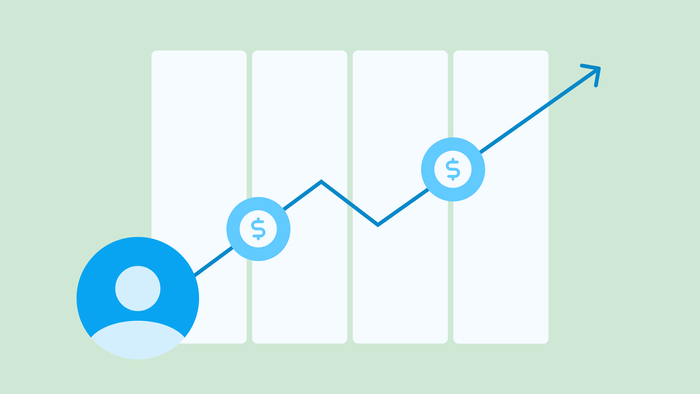You’ve got the business idea.
You’ve got the vision and the dedication.
The only thing you’re missing to launch your startup is … funding.
If you‘re unable to raise funds and don’t want to take out huge loans to launch your business, bootstrap financing might be a promising option for you. But you might be wondering:
- Can bootstrapping work if I don’t have a huge savings account?
- Is bootstrapping too risky?
- How much will it cost to bootstrap my business?
We’ll answer all of those questions and more in this article.
What is bootstrapping?
Bootstrapping — also known as “self-funding” — is the process of launching and growing your startup with your own money and personal resources.
Bootstrapped companies use minimal external capital. It’s often compared to raising venture capital (VC) funding. Venture capital funding involves raising money from a team of venture capitalists — private investors typically backed by a firm — in exchange for equity in your company.
Instead, they use the founder’s personal savings, investments from family and friends, and early profits and revenue.
Some founders may use business credit cards or take out a business loan, but keep it to a minimum. At Bubble, we think of bootstrapping as funding your startup completely with cash you have, either savings or early revenue.
Either way, the idea is that the business owner is funding the company themselves and not spending more than they actually make.
Pros and cons of bootstrapping
Bootstrapping is sometimes viewed as a less viable option than raising VC funds or taking on loans or external support, but that’s just not true.
Like every funding option for startups, bootstrapping comes with pros and cons:
Benefits of bootstrapping your startup
In general, a bootstrapped company offers the founders more control over their business, more freedom, and more flexibility.
Greater control over business decisions
When you haven’t taken outside funding, you get to have more control over business decisions. You’re not responsible to a team of investors, and you haven’t transferred equity outside the company.
This can make it easier to pivot faster when needed. It can also give you more flexibility to experiment, try new things, and generally run your company in line with your vision.
Full ownership of the company
Similarly, you get to have full ownership of your company. When you raise VC funding (or occasionally, other types of funding), you trade funding for a substantial equity stake in your company.
This means you’re no longer 100% in control, and you won’t be keeping 100% of the profits either. This isn’t necessarily a bad thing — but maintaining full ownership gives you a greater ability to manage your company the way you want to and stay aligned with your vision and values.
Easier to get started
Bootstrapping often allows founders to get started faster, which may seem counterintuitive. But more money only gives you more traction once you’ve acquired it.
Acquiring external funding isn’t a sure thing, and it can take a long time to get it:
- You often need to build an MVP and gain some traction before you can convince investors or other lending institutions to take a chance on you.
- Small business loans can be difficult to qualify for and time-consuming to apply for.
- You need to build a crowd before you can crowdfund.
When bootstrapping, you lean into personal funds for initial funding. This means you can spend more time focusing on the product, your audience, and the idea itself.
Promotes cost sensitivity/sustainability
Another major benefit of bootstrapping is that it encourages you to grow your business at a sustainable rate.
When you’re bootstrapping, you can’t spend what you don’t have. This means you have to develop a business model that really works, and focus on immediate cash flow and profit right from the start.
More focus on customer needs (vs. investor needs)
As a small business, you need to focus on customer needs to grow your audience and develop strong product-market fit.
However, when you’re also subject to the needs and opinions of investors, it can be hard to focus on customer needs as much as you want to. This is especially so if the needs of your investors are at odds with those of your customers.
Bootstrapping offers you the opportunity to focus on your customers, do things that won’t scale, and move quickly. Sure, you’ll need to be scrappier — but, in exchange, you get more flexibility and agility.
Disadvantages of bootstrapping your startup
Of course, bootstrapping isn’t a silver bullet, and it’s not right for every startup. Bootstrapping requires hard work and dedication, comfortability with risk, and a fitting business model.
Increased financial risk
As a founder, you often end up taking on more financial risk when you bootstrap. After all, if your business fails, it’s mostly your personal assets that are going to take the hit. Many founders may not be comfortable sinking their personal finances into something that’s essentially an experiment.
However, you can mitigate financial risk when you start by creating a detailed business plan and cost estimates. By reducing expenses and focusing on profitability from the outset, you can reduce your own financial risk while also moving into the customer-funded stage more quickly.
Fewer resources
Unless you’re independently wealthy (and many founders aren’t), bootstrapping generally means you’ll have fewer resources to lean on, at least in the early stages.
Compared to raising funds or taking out a significant business loan, bootstrapping is reliant on whatever resources you have already at your disposal. If you have limited resources, you may not be able to build traction quickly enough to move past the early startup phase.
That said, having a lot of funding early on doesn’t guarantee your startup will be successful. It can make some things easier, but a great idea combined with great talent and a scrappy mentality can be just as successful as a VC-backed startup.
Slower business growth
Similarly, fewer resources often mean your company grows more slowly. You won’t have as many resources to invest in things like:
- Paid advertising
- Product development
- Hiring employees
- Marketing and sales
- Publicity
All of these can help your business grow faster. When you bootstrap, you have to focus on more organic growth methods, like customer satisfaction and word-of-mouth, developing product-market fit, and so on.
Slower business growth can mean that you don’t gain enough traction to ever become profitable or get off the ground. However, it can also mean that you grow your business at a steady, sustainable rate, fueled by real audience growth and revenue — not artificially inflated by investments and loans.
Less credibility
In some cases, raising VC funding very early on can have a halo effect on your startup’s credibility. The “seal of approval” from venture capitalists can help you attract media coverage, top talent, and a network of companies and vendors who know your name.
However, VC funding isn’t a ticket to success and endless happiness. Plenty of bootstrapped companies go on to grow into thriving, major corporations. Some bootstrap for the early stages, then raise impressive rounds of VC funding once they’ve laid a strong foundation; others bootstrap until they’re profitable and then scale independently with organic revenue.
For example, MailChimp, Apple, Github, GoPro, and even Bubble — just to name a few — all started as bootstrapped companies.
Vulnerability to competitors
In some cases, bootstrapping can introduce more vulnerability to competitors, depending on your industry and company type.
If your competitors have more resources and visibility than you do, it can be tough to keep up. For example, if a competitor is able to throw 10X the amount of spend into their marketing and branding as you, it can be difficult to gain traction with your audience.
However, when you’re bootstrapping, you have full control over your product.
This means that you’re likely to be able to iterate faster, do more user testing, and quickly make customer-facing changes that improve product-market fit. This can be a really effective way of gaining competitive advantage.
You may not be the biggest, but you can be the best. Excellent product-market fit and customer obsession has a way of paying off over time.
2024 self-funding statistics
Bootstrapping isn’t for everyone — but it’s definitely becoming a more popular option, and one that often pays off. According to one survey, 40% of small business owners finance their startup with cash — in fact, it's the most popular option of financing. (And among Bubble users, that number goes up to 80%!)
Meanwhile, according to a study by Lenido, 43% of business owners needed less than $10,000 to get their business up and running.
There are two big reasons for the rise in bootstrapping:
Firstly, external funding is harder to come by. The vast majority of startups (around 97%) never receive VC funding. After the boom in VC funding and investments in 2021–2022, a lot of VC funding has cooled down. This means it’s harder to raise funding, and often harder to qualify for loans and accelerators, too.
Not to mention that VC funding can be even harder for women-led or minority-owned startups to raise. Even in 2022, only 2% of VC funding went to women-led startups, even though about 20% of startups are women-led. (Given pay gaps, bootstrapping is also often harder for women-led startups, especially women of color — but it’s often their only option.)
Secondly, DIY tools and low-cost solutions are more available than ever. Gone are the days of having to hire an entire team and pay for expensive software and equipment just to get your product built, website launched, and share it with an audience. No-code development platforms like Bubble allow even non-technical founders to develop their product on their own. This can save hundreds of thousands of dollars and significant development time. Other low-cost solutions and DIY solutions mean you can do more with fewer people and resources, making bootstrapping a more practical option.
While VC funding may be highly visible, it accounts for funding a very small percentage of startups. In actuality, self-funding is one of the most popular funding methods available, and is becoming more and more feasible with the advent of more cost-effective tools.
Bootstrapping vs. other funding methods
That’s not to say that bootstrapping is the perfect — or only — solution for every business. Here’s a quick look at how bootstrapping stacks up against other funding options, so you can see which one(s) might be right for your startup.
Bootstrapping vs. venture funding
Venture funding is one of the most visible (and in many cases, coveted) forms of startup funding. This is because VC funding rounds tend to raise very significant amounts ($2-$15 million for Series A, $50 million+ for Series B), and it doesn’t have to be repaid like a loan does.
Bootstrapping vs. crowdfunding
Crowdfunding involves leveraging an existing (or growing) audience to raise funds for your product. Individuals who are interested in your product or company “invest” a small amount (usually between $5–$500 each), giving you the capital you need to make your idea a reality.
Unlike bootstrapping, crowdfunding often happens before your product is developed, and usually requires you to have an existing audience or generate some virality to work. After all, you can’t crowdfund without a crowd.
Bootstrapping uses your audience as well, but it provides the audience with an existing product (even if it’s a basic MVP) and relies on revenue from purchases and subscriptions for future funding.
Bootstrapping vs. debt-based financing
Debt-based financing involves taking out significant business loans or relying on business credit cards to fund your startup.
Debt financing can feel less risky. After all, you’re not pouring all of your personal savings into your startup. However, if your startup fails, you’re still going to be on the hook for all of those bank loans — which can come with high interest rates.
For this reason, debt financing isn’t a great option for startups who aren’t sure they’ll be able to earn back the money they borrowed.
For more funding options, check out our guide to startup financing.
How to bootstrap your business
Bootstrapping is one of the most straightforward funding options for small businesses. There aren’t any complicated application processes or qualification requirements, and you don’t need to have an audience, a network, or even the perfect elevator pitch.
That said, a few core tactics will make your bootstrapping financing more effective and give you a strong financial foundation to launch from.
Figure out your costs
Before you try to bootstrap, sit down and do a detailed cost analysis.
If you don’t know how much your business is going to cost, you can’t effectively bootstrap, because you’ll have no idea how long your cash is going to last.
You’ll want to think through things like:
- Your one-time expenses involved with launching
- Recurring, fixed expenses like rent for office space or insurance
- Ongoing, variable expenses like development costs, software, and marketing
- Labor and employee costs, including any outsourcing
- Taxes (including sales taxes, if applicable)
If you’re a first-time founder, we walk you through how to do so in our guide to startup business costs.
Make a business plan
Creating a thorough business plan is essential — even if you’re not planning on pitching to investors anytime soon.
A business plan details your business goals, your product or services, your target market, a competitive analysis, funding plans, marketing and sales plans, and how you plan to develop and operate your business.
A business operating plan can also help you understand what your funding sources are and exactly how much cash (i.e., “runway”) you have. With this in mind, you can create a plan to “break even” or become profitable within a reasonable timeframe based on your resources — giving your business a higher chance of success.
Focus on profitability
Profitability is super important when bootstrapping. You’ll give yourself some runway from your personal savings and financial resources, but you’ll want to start bringing in real revenue as quickly as possible to continue growing.
As such, you’ll want to focus on what’s making money in your business. This could look like:
- Releasing an MVP quickly. Getting an MVP out in the world helps you build an audience, see how your target market uses your product, and gives you valuable customer feedback. It also allows you to start charging and creating revenue from your product right away. No-code tools like Bubble allow you to build and launch an MVP within weeks, instead of months or years, making this process much faster.
- Keeping the customer at the forefront. When you keep the customer at the heart of your decision-making, you can iterate more quickly and stay aligned with what the customer actually wants. Bubbler George Collier is bootstrapping his AI-powered essay tutor on Bubble. He told us, “[Just start by launching] an MVP solution, and learn how your users use your product, as it’ll be different to how you imagined it. Then, maintain a close relationship with them to iterate rapidly and outpace any competition.”
- Be willing to pivot. There are plenty of examples of companies who started out focusing on one solution, and then successfully pivoted — and exploded with growth — once they realized customers were using their product in a totally different way. Pay attention to how customers are using your product and be willing to pivot to serve their needs — you’ll capture more market share and revenue in the long-run.
Cut unnecessary costs and actions
When you’re bootstrapping, you can’t spend cash you don’t have. One of the best ways to extend your runway, then, is to reduce your costs so your funding stretches further.
Adopt a cost-conscious decision mindset to reduce unnecessary spending. For example, you could:
- Opt for a coworking space rather than paying for an expensive dedicated office. Or, build a fully-remote team instead.
- Use a no-code development platform instead of hiring a dev team for traditional coding. No-code tools not only require fewer resources and investment, but also allow you to build, launch, and iterate faster.
- Hire generalists or work with contractors instead of trying to hire a full-time, in-house team right off the bat.
- Lease equipment and software instead of buying it, which can both reduce your upfront costs and give you more flexibility to shift to other tools as your needs change.
You can also cut costs by focusing your work on the most essential actions first. Avoid getting lured into “shiny object syndrome” and focusing on too many bells and whistles early on. Build and launch your MVP, start generating some revenue and user feedback, and then iterate and improve from there.
Build your network
Even if you’re bootstrapping, no founder can make it totally on their own.
A strong network can give you the support you need through:
- Offering mentorship, guidance, and decision-making support
- Providing recommendations for contractors or new hires
- Sharing about your startup and helping create more visibility
- Giving you early feedback and helping test your product
- Offering peer-to-peer lending or investing
Your network will be an invaluable resource as you journey the often bumpy road of a startup founder. So don’t hesitate to invest by making the most of networking opportunities to connect with other founders and folks in your industry, share knowledge, and ask for help.
Successful bootstrapped companies
Bootstrapping can be an incredibly effective way to build and grow your company. Consider these successfully bootstrapped companies:
Mailchimp. The popular email marketing platform was founded by three co-founders as a side project, and was entirely bootstrapped. Since it had to become profitable quickly for the founders to keep it running, they never had a need to raise VC funding, and today drive over $700 million annually in revenue.
Github. The popular development platform also started as an entirely bootstrapped company for the first four years. The founders worked on Github alongside their full-time jobs, and revenue from Github’s customers allowed the team to hire employees and grow the company before ever raising outside funding.
Flexiple. Flexiple is a global talent and development platform built on Bubble — and completely bootstrapped by three young entrepreneurs. “We spent all the money we had,” co-founder Karthik Sridharan said. But once they made the switch to Bubble, “the level of empowerment… and the speed with which we could build was so much quicker.” Now, Flexiple has scaled to $3 million in annual revenue, while remaining completely bootstrapped.
Bubble. Of course, we have to mention our own success story with bootstrapping. Bubble’s founders, Emmanuel Straschnov and Josh Haas, self-funded Bubble for seven years before ever taking in outside investments. Bootstrapping allowed our team to focus on
investing in our community and making a product they’d truly love and that would serve their needs first, before trying to scale and attract investors.
Start building on Bubble
For bootstrapped companies looking to build, launch, and grow fast, Bubble is the best product-development solution.
With Bubble’s no-code platform, you can build secure, scalable, professional web apps and websites in a fraction of the time it takes to build them with traditional development methods. With no-code, you:
- Get free access to development: Build for free until you’re ready to launch
- Need fewer resources and specialized skills: You can build yourself, or with a single Bubble engineer
- Have fewer development costs: Build for free, then launch and host your app starting from $25/mo.
- Can generate revenue faster: Build and launch your app in weeks, not months
- Can iterate faster: Which makes finding product-market fit faster and easier
In short, using a no-code product development platform like Bubble bypasses some of the biggest obstacles for bootstrapped founders. No-code makes product development much more accessible, both technically and financially.
And if you get stuck building at any point, you can tap into our community on the Forum for help, or get step-by-step help building all kinds of apps by generating a custom build guide.
Build for as long as you want on the Free plan. Only upgrade when you're ready to launch.
Join Bubble






